| Set of regular n-gonal dihedra | |
|---|---|
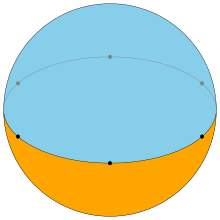 Example hexagonal dihedron on a sphere | |
| Type | Regular polyhedron or spherical tiling |
| Faces | 2 n-gons |
| Edges | n |
| Vertices | n |
| Vertex configuration | n.n |
| Wythoff symbol | 2 | n 2 |
| Schläfli symbol | {n,2} |
| Coxeter diagram | |
| Symmetry group | Dnh, [2,n], (*22n), order 4n |
| Rotation group | Dn, [2,n]+, (22n), order 2n |
| Dual polyhedron | n-gonal hosohedron |
A dihedron is a type of polyhedron, made of two polygon faces which share the same set of edges. In three-dimensional Euclidean space, it is degenerate if its faces are flat, while in three-dimensional spherical space, a dihedron with flat faces can be thought of as a lens, an example of which is the fundamental domain of a lens space L(p,q).[1] Dihedra have also been called bihedra,[2] flat polyhedra,[3] or doubly covered polygons.[3]
A regular dihedron is the dihedron formed by two regular polygons that may be described by the Schläfli symbol {n,2}.[4] As a spherical polyhedron, each polygon of such a dihedron fills a hemisphere, with a regular n-gon on a great circle equator between them.
The dual of a n-gonal dihedron is the n-gonal hosohedron, where n digon faces share two vertices.
As a polyhedron
A dihedron can be considered a degenerate prism consisting of two (planar) n-sided polygons connected "back-to-back", so that the resulting object has no depth. The polygons must be congruent, but glued in such a way that one is the mirror image of the other.
Dihedra can arise from Alexandrov's uniqueness theorem, which characterizes the distances on the surface of any convex polyhedron as being locally Euclidean except at a finite number of points with positive angular defect summing to 4π. This characterization holds also for the distances on the surface of a dihedron, so the statement of Alexandrov's theorem requires that dihedra be considered to be convex polyhedra.[5]
As a tiling on a sphere
As a spherical tiling, a dihedron can exist as nondegenerate form, with two n-sided faces covering the sphere, each face being a hemisphere, and vertices around a great circle. (It is regular if the vertices are equally spaced.)
The regular polyhedron {2,2} is self-dual, and is both a hosohedron and a dihedron.
| Image | 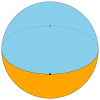 | 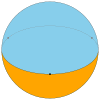 | 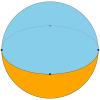 | 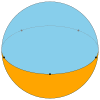 | 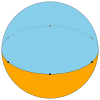 |
| Schläfli | {2,2} | {3,2} | {4,2} | {5,2} | {6,2}... |
|---|---|---|---|---|---|
| Coxeter | |||||
| Faces | 2 {2} | 2 {3} | 2 {4} | 2 {5} | 2 {6} |
| Edges and vertices | 2 | 3 | 4 | 5 | 6 |
Apeirogonal dihedron
In the limit the dihedron becomes an apeirogonal dihedron as a 2-dimensional tessellation:
Ditopes
A regular ditope is an n-dimensional analogue of a dihedron, with Schläfli symbol {p,...q,r,2}. It has two facets, {p,...q,r}, which share all ridges, {p,...q} in common.[6]
See also
References
- ^ Gausmann, Evelise; Roland Lehoucq; Jean-Pierre Luminet; Jean-Philippe Uzan; Jeffrey Weeks (2001). "Topological Lensing in Spherical Spaces". Classical and Quantum Gravity. 18 (23): 5155–5186. arXiv:gr-qc/0106033. Bibcode:2001CQGra..18.5155G. doi:10.1088/0264-9381/18/23/311. S2CID 34259877.
- ^ Kántor, S. (2003), "On the volume of unbounded polyhedra in the hyperbolic space" (PDF), Beiträge zur Algebra und Geometrie, 44 (1): 145–154, MR 1990989.
- ^ a b O'Rourke, Joseph (2010), Flat zipper-unfolding pairs for Platonic solids, arXiv:1010.2450, Bibcode:2010arXiv1010.2450O
- ^ Coxeter, H. S. M. (January 1973), Regular Polytopes (3rd ed.), Dover Publications Inc., p. 12, ISBN 0-486-61480-8
- ^ O'Rourke, Joseph (2010), On flat polyhedra deriving from Alexandrov's theorem, arXiv:1007.2016, Bibcode:2010arXiv1007.2016O
- ^ McMullen, Peter; Schulte, Egon (December 2002), Abstract Regular Polytopes (1st ed.), Cambridge University Press, p. 158, ISBN 0-521-81496-0
